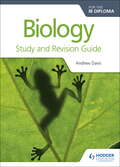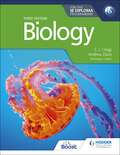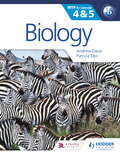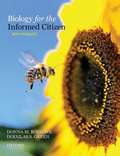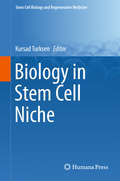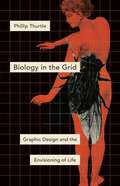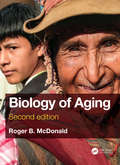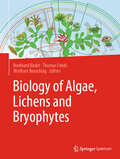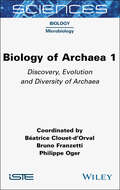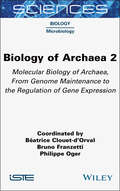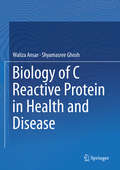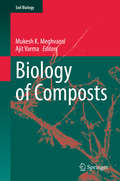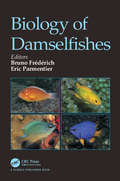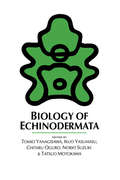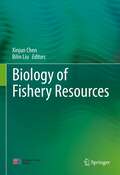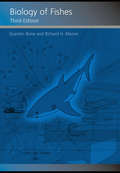- Table View
- List View
Biology for the IB Diploma Second Edition
by C. J. CleggProvide clear guidance to the 2014 changes and ensure in-depth study with accessible content, directly mapped to the new syllabus and approach to learning.This second edition of the highly regarded textbook contains all SL and HL content, which is clearly identified throughout. Options are available free online, along with appendices and data and statistics.- Improve exam performance, with exam-style questions, including from past papers- Integrate Theory of Knowledge into your lessons and provide opportunities for cross-curriculum study- Stretch more able students with extension activities- The shift to concept-based approach to learning , Nature of Science, is covered by providing a framework for the course with points for discussion - Key skills and experiments included
Biology for the IB Diploma Study and Revision Guide
by Andrew Davis C. J. CleggStretch your students to achieve their best grade with these year round course companions; providing clear and concise explanations of all syllabus requirements and topics, and practice questions to support and strengthen learning. - Consolidate revision and support learning with a range of exam practice questions and concise and accessible revision notes- Practise exam technique with tips and trusted guidance from examiners on how to tackle questions- Focus revision with key terms and definitions listed for each topic/sub topic
Biology for the IB Diploma Study and Revision Guide
by Andrew Davis C. J. CleggExam Board: IBLevel: IBSubject: BiologyFirst Teaching: September 2014First Exam: Summer 16Stretch your students to achieve their best grade with these year round course companions; providing clear and concise explanations of all syllabus requirements and topics, and practice questions to support and strengthen learning. - Consolidate revision and support learning with a range of exam practice questions and concise and accessible revision notes- Practise exam technique with tips and trusted guidance from examiners on how to tackle questions- Focus revision with key terms and definitions listed for each topic/sub topic
Biology for the IB Diploma Third edition
by Andrew Davis C. J. CleggDeveloped in cooperation with the International Baccalaureate®Trust experienced and best-selling authors to navigate the new syllabuses confidently with these coursebooks that implement inquiry-based and conceptually-focused teaching and learning.- Ensure a continuum approach to concept-based learning through active student inquiry; our authors are not only IB Diploma experienced teachers but are also experienced in teaching the IB MYP and have collaborated on our popular MYP by Concept series. - Build the skills and techniques covered in the Tools (Experimental techniques, Technology and Mathematics) with direct links to the relevant parts of the syllabus; these skills also provide the foundation for practical work and internal assessment.- Integrate Theory of Knowledge into your lessons with TOK boxes and Inquiries that provide real-world examples, case studies and questions. The TOK links are written by the author of our bestselling TOK coursebook, John Sprague and Paul Morris, our MYP by Concept series and Physics co-author.- Develop approaches to learning with ATL skills identified and developed with a range of engaging activities with real-world applications. - Explore ethical debates and how scientists work in the 21st century with Nature of Science boxes throughout. - Help build international mindedness by exploring how the exchange of information and ideas across national boundaries has been essential to the progress of science and illustrates the international aspects of science. - Consolidate skills and improve exam performance with short and simple knowledge-checking questions, exam-style questions, and hints to help avoid common mistakes.
Biology for the IB Diploma Third edition
by Andrew Davis C. J. CleggDeveloped in cooperation with the International Baccalaureate®Trust experienced and best-selling authors to navigate the new syllabuses confidently with these coursebooks that implement inquiry-based and conceptually-focused teaching and learning.- Ensure a continuum approach to concept-based learning through active student inquiry; our authors are not only IB Diploma experienced teachers but are also experienced in teaching the IB MYP and have collaborated on our popular MYP by Concept series. - Build the skills and techniques covered in the Tools (Experimental techniques, Technology and Mathematics) with direct links to the relevant parts of the syllabus; these skills also provide the foundation for practical work and internal assessment.- Integrate Theory of Knowledge into your lessons with TOK boxes and Inquiries that provide real-world examples, case studies and questions. The TOK links are written by the author of our bestselling TOK coursebook, John Sprague and Paul Morris, our MYP by Concept series and Physics co-author.- Develop approaches to learning with ATL skills identified and developed with a range of engaging activities with real-world applications. - Explore ethical debates and how scientists work in the 21st century with Nature of Science boxes throughout. - Help build international mindedness by exploring how the exchange of information and ideas across national boundaries has been essential to the progress of science and illustrates the international aspects of science. - Consolidate skills and improve exam performance with short and simple knowledge-checking questions, exam-style questions, and hints to help avoid common mistakes.
Biology for the IB MYP 4 & 5: By Concept
by Andrew Davis Patricia DeoEndorsed by the IBDrive meaningful inquiry through a unique concept-driven narrative.- Supports every aspect of assessment with opportunities that use the criteria- Gives you easy ways to differentiate and extend learning- Provides a meaningful approach by integrating the inquiry statement in a global context- Develops critical-thinking skills with activities and summative sections rooted in the ATL frameworkThis title is also available in two digital formats via Dynamic Learning. Find out more by clicking on the links at the top of the page.
Biology for the IB MYP 4 & 5: By Concept (MYP By Concept)
by Andrew Davis Patricia DeoThe only series for MYP 4 and 5 developed in cooperation with the International Baccalaureate (IB)Develop your skills to become an inquiring learner; ensure you navigate the MYP framework with confidence using a concept-driven and assessment-focused approach presented in global contexts.- Develop conceptual understanding with key MYP concepts and related concepts at the heart of each chapter.- Learn by asking questions with a statement of inquiry in each chapter. - Prepare for every aspect of assessment using support and tasks designed by experienced educators.- Understand how to extend your learning through research projects and interdisciplinary opportunities.This title is also available in two digital formats via Dynamic Learning. Find out more by clicking on the links at the top of the page.
Biology for the Informed Citizen with Physiology
by Donna M. Bozzone Douglas S. GreenWith Biology for the Informed Citizen, students connect the concepts of biology to the consequences of biology. Authors Donna M. Bozzone and Douglas S. Green teach the concepts of biology, evolution, and the process of science so that students can apply their knowledge as informed consumers and users of scientific information. <p><p> Cases: An engaging biological issue opens every chapter and is revisited throughout <p> Concepts: Foundational biological ideas are introduced within the context of important cultural and social issues <p> Consequences: The concepts and consequences of biology are connected in order to help students make informed decisions about biological issues
Biology in Stem Cell Niche: Methods And Protocols (Stem Cell Biology and Regenerative Medicine #1035)
by Kursad TurksenThis comprehensive volume explores functions, pathologies, and applications of stem cells in relation to the niches in which they develop. Ten chapters cover the subject in depth, from a historical perspective through signaling, hormonal control, quiescence, biomimetics, epigenetics, engineering strategies for emulating, tumorigenesis and more. The chapter authors represent a broad range of international expertise and perspectives. This installment of the popular Stem Cell Biology and Regenerative Medicine series delivers authoritative, international perspectives on this rapidly growing field. Biology of Stem Cell Niche is an ideal complementary volume to Tissue-Specific Stem Cell Niche and Adult Stem Cells, Second Edition and will be invaluable to clinicians and researchers working with stem cells as well as to postgraduate trainees who are studying them.
Biology in the Grid: Graphic Design and the Envisioning of Life (Posthumanities)
by Phillip ThurtleHow grids paved the way for our biological understanding of organisms As one of the most visual sciences, biology has an aesthetic dimension that lends force and persuasion to scientific arguments: how things are arranged on a page, how texts are interspersed with images, and how images are composed reflect deep-seated beliefs about how life exists on Earth. Biology in the Grid traces how our current understanding of life and genetics emerged from the pervasive nineteenth- and twentieth-century graphic form of the grid, which allowed disparate pieces of information to form what media theorist Vilém Flusser called &“technical images.&”Phillip Thurtle explains how the grid came to dominate biology in the twentieth century, transforming biologists&’ beliefs about how organisms were constructed. He demonstrates how this shift in our understanding of biological grids enabled new philosophies in endeavors such as advertising, entertainment, and even political theory. The implications of the arguments in Biology in the Grid are profound, touching on matters as fundamental as desire, our understanding of our bodies, and our view of how society is composed. Moreover, Thurtle&’s beautifully written, tightly focused arguments allow readers to apply his claims to new disciplines and systems. Bristling with insight and potential, Biology in the Grid ultimately suggests that such a grid-organized understanding of natural life inevitably has social and political dimensions, with society recognized as being made of interchangeable, regulated parts rather than as an organic whole.
Biology of Aging
by Roger B. McDonaldBiology of Aging, Second Edition presents the biological principles that have led to a new understanding of the causes of aging and describes how these basic principles help one to understand the human experience of biological aging, longevity, and age-related disease. Intended for undergraduate biology students, it describes how the rate of biological aging is measured; explores the mechanisms underlying cellular aging; discusses the genetic pathways that affect longevity in various organisms; outlines the normal age-related changes and the functional decline that occurs in physiological systems over the lifespan; and considers the implications of modulating the rate of aging and longevity. The book also includes end-of-chapter discussion questions to help students assess their knowledge of the material. Roger McDonald received his Ph.D. from the University of Southern California and is Professor Emeritus in the Department of Nutrition at the University of California, Davis. Dr. McDonald’s research focused on mechanisms of cellular aging and the interaction between nutrition and aging. His research addressed two key topics in the field: the relationship between dietary restriction and lifespan, and the effect of aging on circadian rhythms and hypothalamic regulation. You can contact Dr. McDonald at rbmcdonald@ucdavis.edu. Related Titles Ahmad, S. I., ed. Aging: Exploring a Complex Phenomenon (ISBN 978-1-1381-9697-1) Moody, H. R. & J. Sasser. Gerontology: The Basics (ISBN 978-1-1387-7582-4) Timiras, P. S. Physiological Basis of Aging and Geriatrics (ISBN 978-0-8493-7305-3)
Biology of Algae, Lichens and Bryophytes
by Wolfram Beyschlag Burkhard Büdel Thomas FriedlAs a reader of this book you will become familiar with current, up-to-date comprehensive knowledge about all classes of eukaryotic algae, the cyanobacteria, and symbiotic interactions of algae and cyanobacteria with other organisms. For example, the lichens are symbiotic consortia and a prominent example of a particularly successful ‘evolution by cooperation’. We expand even to the beginnings of terrestrial plant life and the bryophytes, which are gradually transmitting to the vascular plants. We collectively call this enormous phylogenetic wealth of photoautotrophic organisms the ‘new cryptogams’, abandoning the traditional definition of cryptogams. The new cryptogams are all those autotrophic organisms that share being hydro-passive, meaning that they are unable of controlling water uptake or release, in contrast to vascular plants. While being basal of and phylogenetically much more diverse than the vascular plants, the new cryptogams are ecologically highly relevant in all ecosystems of our Planet. They are responsible for more than half of the Earth’s annual oxygen production.
Biology of Archaea, Volume 1: Discovery, Evolution and Diversity of Archaea (ISTE Invoiced)
by Béatrice Clouet-d'Orval Bruno Franzetti Philippe OgerArchaea constitute a new branch of life alongside bacteria and eukaryotes. These microorganisms are unique in their cellular and molecular aspects. They have evolutionary links with the first eukaryotic cells and are now being used to elucidate fundamental biological questions. Champions of extremophilicity, archaea are helping to lift the veil on the limits of life on Earth. Biology of Archaea 1 explores the discovery and evolution of the field of archaea research. This book also looks at the evolutionary history of archaea and their integration into the tree of life, and examines this complex and extremely diverse world in terms of their ecological niches and their still largely unexplored virosphere.
Biology of Archaea, Volume 2: Molecular Biology of Archaea, From Genome Maintenance to the Regulation of Gene Expression (ISTE Invoiced)
by Béatrice Clouet-d'Orval Bruno Franzetti Philippe OgerArchaea constitute a new branch of life alongside bacteria and eukaryotes. These microorganisms are unique in their cellular and molecular aspects. They have evolutionary links with the first eukaryotic cells and are now being used to elucidate fundamental biological questions. Champions of extremophilicity, archaea are helping to lift the veil on the limits of life on Earth. Biology of Archaea 2 presents the diverse molecular mechanisms involved in the fundamental processes of genome maintenance and regulation of gene expression in archaeal cells. This book analyzes the complex machinery involved in chromosome replication, DNA repair, RNA synthesis (transcription) and protein synthesis (translation), and explores the different classes of RNAs and enzymes involved in RNA maturation and degradation. These regulate the stability of messenger and regulatory non-coding RNAs, and contribute to the formation of the mature forms of ribosomal RNAs and transfer RNAs. These molecular mechanisms are closely related to those of eukaryotes.
Biology of Bats
by William A. WimsattBats had mastered flight eons before man's own lineage began. Their unique volitional mode was obviously advantageous, for adaptive radiation within the group has been little short of extraordinary. Today Chiroptera represent the second largest order of mammals in number of species and the largest in overall abundance; excluding man, and possibly rodents, they are also the most widely distributed land-based mammals.
Biology of C Reactive Protein in Health and Disease
by Waliza Ansar Shyamasree GhoshThis book offers a comprehensive study of C-reactive protein (CRP) belonging to the pentraxin family, including a brief history of CRP, its structure, synthesis and evolution. Focusing on the emerging role of CRP and its clinical application in the field of disease biology, it details the pathophysiological role of CRP in a host of diseases such as cardiovascular disease, diabetes, cancers, rheumatoid arthritis and infectious diseases and others. It also discusses the role of innate immunity and acute phase response (APR) and their key mediators in the host body in response to tissue injury, infection, trauma or surgery, immunological disorders or neoplastic growth. CRP's significance in inflammation is highlighted, and its importance as a clinical marker in cardiovascular disease, its functional significance in Leishmania and Plasmodium infections, its association with the development of insulin resistance in type 2 diabetes mellitus, and its role in cancer are discussed in detail. The book also includes clinical data studies and presents the latest research advances to further readers' understanding of CRP.
Biology of Composts (Soil Biology #58)
by Ajit Varma Mukesh K. MeghvansiThis book highlights the latest findings on fundamental aspects of composting, the interaction of various microorganisms, and the underlying mechanisms. In addition to addressing modern tools and techniques used for composting research, it provides an overview of potential composting applications in both agriculture and environmental reclamation.Composting is the process of organic waste decomposition, mediated by microorganisms. The end-product is called ‘compost’ and can be used as a supplement to improve soil fertility. As the municipal waste generated in most developing countries contains a substantial amount of organic matter suitable for composting, this technology offers a win-win opportunity for stakeholders in terms of disposing of organic waste and providing organic fertilizers for agriculture. In addition, using compost reduces the dependency on harmful chemical fertilizers, and represents a sustainable and environmentally friendly alternative.
Biology of Damselfishes
by Bruno Frédérich Eric ParmentierDamselfishes (Pomacentridae) are highly conspicuous, diurnal inhabitants of mainly reef areas, capturing the attention of many scientists. Their high diversity and the many interesting characteristics dealing with their way of life (sound production, breeding biology, sex change, farming and gregarious behavior, settlement, diet, habitat) easily explain how this group is continually kept in the limelight and is the subject of numerous studies. This book gathers the data dealing with damselfish morphology, physiology, behavior, ecology and phylogeny.It contains 14 chapters written by renowned scientists.
Biology of Disease
by Chris Smith Ed Wood Nessar Ahmed Maureen DawsonBiology of Disease describes the biology of many of the human disorders and disease that are encountered in a clinical setting. It is designed for first and second year students in biomedical science programs and will also be a highly effective reference for health science professionals as well as being valuable to students beginning medical school. Real cases are used to illustrate the importance of biology in understanding the causes of diseases, as well as in diagnosis and therapy.
Biology of Domestic Animals
by Rodney A. Hill Colin G. ScanesThere is increasing interest in the biology of domestic animals ranging from genomics, transcriptomics, metabolomics, nutritional physiology, and systems biology. This book touches on all of these, with a particular focus on topics such as domestic animals as comparative models to humans, molecular regulation of growth, metabolic efficiency, reproduction, and the impact of stress on growth and development. The book concludes with a discussion on the current and future directions for researchers.
Biology of Earthworms (Soil Biology #24)
by Ayten KaracaEarthworms, which belong to the order Oligochaeta, comprise roughly 3,000 species grouped into five families. Earthworms have been called 'ecosystem engineers'; much like human engineers, they change the structure of their environments. Earthworms are very versatile and are found in nearly all terrestrial ecosystems. They play an important role in forest and agricultural ecosystems. This Soil Biology volume describes the various facets of earthworms, such as their role in soil improvement, soil structure, and the biocontrol of soil-borne plant fungal diseases. Reviews discuss earthworms' innate immune system, molecular markers to address various issues of earthworm ecology, earthworm population dynamics, and the influences of organic farming systems and tillage. Further topics include the characteristics of vermicompost, relationships between soil earthworms and enzymes, the role of spermathecae, copulatory behavior, and adjustment of the donated sperm volume.
Biology of Echinodermata
by T. YanagisawaThe proceedings of the Seventh International Echinoderm Conference, held at Atami, Japan, September 1990. In addition to sections covering ecology, evolution, reproduction, morphology, molecular biology, developmental biology, physiology, behavior, and paleontology, there are four plenary lectures a
Biology of Fishery Resources
by Xinjun Chen Bilin LiuThis auto-translation book overviews the fish population and its research methods, help readers in understanding the concept of fish population and population identification. It divides into seven chapters according to the characteristics of the subject and the development results. Based on a systematic introduction to the basic concepts and research contents of the biology of fishery resources, the book focuses on the introduction of fish populations and research methods, life history division and early development identification, age identification and growth research, the division of sexual maturity, the determination of reproductive habits and fecundity, feeding characteristics and research methods of fish, and the mechanism of fish colony and migration. Through the study of this course, we can master the basic theory and methods of fish biology research and lay a solid foundation for future researches on fishery resources. This book can be used as a reference book for undergraduates and postgraduates who study fishery resources, as well as for those who are engaged in fishery and marine research. The translation was done with the help of artificial intelligence (machine translation by the service DeepL.com). A subsequent human revision was done primarily in terms of content.
Biology of Fishes
by Richard Moore Quentin BoneThe VitalBook e-book version of Biology of Fishes is only available only in the US and Canada at the present time. To purchase or rent please visit http://store.vitalsource.com/show/978-1-1341-8631-0. The Third Edition of Biology of Fishes is chiefly about fish as remarkably efficient machines for coping with the many problems that life in wat
Biology of Floral Scent
by Eran Pichersky Natalia DudarevaAs with nearly all living creatures, humans have always been attracted and intrigued by floral scents. Yet, while we have been manufacturing perfumes for at least 5000 years to serve a myriad of religious, sexual, and medicinal purposes, until very recently, the limitation of our olfactory faculty has greatly hindered our capacity to clearly and ob

